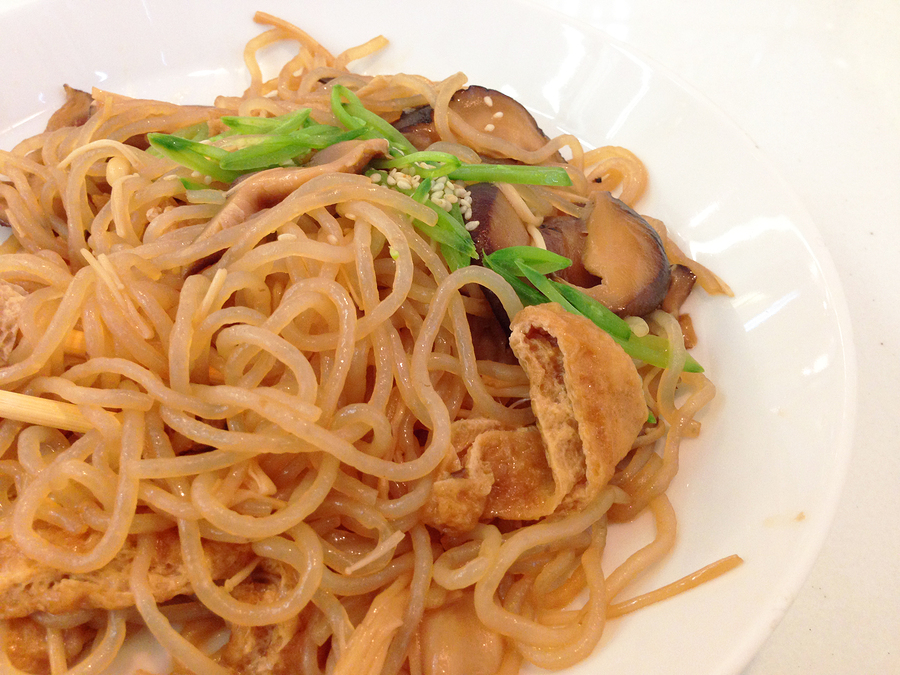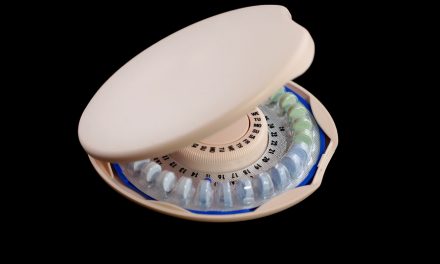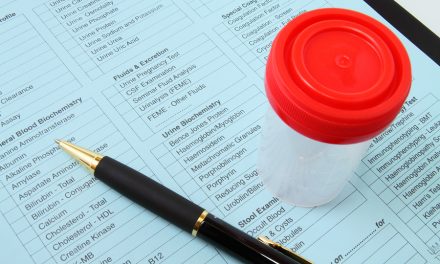(Editor’s Note: My editor, Aimee LOVES these noodles. She says they are easy to make, are relatively inexpensive, and really do take on the flavor of whatever you put them with. Enjoy!)
Shirataki noodles are a unique food that’s very filling yet low in calories.
These noodles also contain a type of fiber that has impressive health benefits.
In fact, this fiber has been shown to cause weight loss in numerous studies.
This article explains everything you need to know about shirataki noodles and their benefits.
It also provides recipes and detailed instructions about how to prepare them.
What are Shirataki Noodles?
Shirataki noodles are long, white noodles. They are often called miracle noodles or konjac noodles.
They’re made from glucomannan, a type of fiber that comes from the root of the konjac plant.
Konjac grows in Japan, China and Southeast Asia. It contains very few digestible carbs, but most of its carbs come from glucomannan fiber.
“Shirataki” is Japanese for “white waterfall,” which describes the noodles’ translucent appearance. This is what they look like:

The noodles are made by combining glucomannan flour with water and a small amount of lime water, which helps the noodles hold their shape.
The mixture is boiled and then shaped into noodles or rice.
Shirataki noodles contain a lot of water. In fact, they are about 97% water and 3% glucomannan fiber. They’re also very low in calories and contain no digestible carbs.
There is also a variation of shirataki noodles known as tofu shirataki noodles.
They are very similar to traditional shirataki noodles, but the tofu provides a few additional calories and a small amount of digestible carbs.
Bottom Line: Shirataki noodles are a low-calorie food made from glucomannan, a type of fiber found in the Asian konjac plant.
Shirataki Noodles Are High in Viscous Fiber
Glucomannan is a highly viscous fiber. Viscous fiber is a type of soluble fiber, and one of its main characteristics is the ability to absorb water and form a gel.
In fact, glucomannan can absorb up to 50 times its weight in water, as reflected in shirataki noodles’ extremely high water content.
These noodles move through the digestive system very slowly, which helps you feel full and delays nutrient absorption into the bloodstream.
In addition, viscous fiber functions as a prebiotic. It nourishes the bacteria living in your colon, also known as the gut flora or microbiome.
In your colon, bacteria ferment fiber into short-chain fatty acids, which can fight inflammation, boost immune function and provide other health benefits.
A recent human study found that fermenting glucomannan fiber to short-chain fatty acids produces one calorie per gram.
Since a typical serving of shirataki noodles contains about 1–3 grams of glucomannan, it’s essentially a calorie-free, carb-free food.
Bottom Line: Glucomannan is a viscous fiber that can hold onto water and slow down digestion. In the colon, it’s fermented into short-chain fatty acids that may provide several health benefits.
Shirataki Noodles Can Help You Lose Weight

Shirataki noodles can be a powerful weight loss tool.
Their viscous fiber delays stomach emptying, so you stay full longer and end up eating less.
In addition, fermenting fiber into short-chain fatty acids can stimulate the release of a gut hormone known as PYY, which increases feelings of fullness.
What’s more, taking glucomannan before a high-carb load appears to reduce levels of the “hunger hormone” ghrelin. It was also shown to reduce fasting ghrelin levels when taken daily for 4 weeks.
Researchers who analyzed 7 weight loss studies found that people who took glucomannan for 4–8 weeks lost 3–5.5 lbs (1.4–2.5 kg).
In one study, people who took glucomannan alone or with other types of fiber lost significantly more weight on a low-calorie diet, compared to the placebo group.
In another study, obese people who took glucomannan every day for 8 weeks lost 5.5 lbs (2.5 kg) without eating less or changing their exercise habits.
However, another 8-week study found no difference in weight loss between overweight and obese people who took glucomannan and those who did not.
Since these studies used 2–4 grams of glucomannan in tablet or supplement form taken with water, shirataki noodles would likely have similar effects.
Nevertheless, there are no studies available on shirataki noodles specifically.
Additionally, timing may play a role. Glucomannan is typically taken up to an hourbefore a meal, while the noodles are eaten as part of the meal.
Bottom Line: Glucomannan promotes feelings of fullness that may cause a spontaneous reduction in calorie intake and lead to weight loss.
Shirataki Noodles Can Reduce Blood Sugar and Insulin Levels
 Glucomannan has been shown to help lower blood sugar levels in people with diabetes and insulin resistance.
Glucomannan has been shown to help lower blood sugar levels in people with diabetes and insulin resistance.
Because viscous fiber delays stomach emptying, blood sugar and insulin levels rise more gradually as nutrients are absorbed into the bloodstream.
In one study, people with type 2 diabetes who took glucomannan for 3 weeks had a significant reduction in fructosamine, which is a test that reflects blood sugar levels over a period of 2–3 weeks.
In another study, type 2 diabetics who took a single dose of glucomannan before a glucose load had significantly lower blood sugar levels 2 hours later, compared to their blood sugar response to a placebo.
Bottom Line: Shirataki noodles can delay stomach emptying, which may help prevent blood sugar spikes after meals.
Shirataki Noodles May Lower Cholesterol

Several studies also suggest that taking glucomannan may help lower cholesterol levels.
Researchers have reported that glucomannan increases the amount of cholesterol excreted in the stool, so less is reabsorbed into the bloodstream.
A review of 14 studies found that glucomannan lowered LDL cholesterol by an average of 16 mg/dL and triglycerides by an average of 11 mg/dl.
Bottom Line: Studies show that glucomannan may help lower LDL cholesterol and triglyceride levels.
Shirataki Noodles May Relieve Constipation
Many people have chronic constipation or infrequent bowel movements that are difficult to pass.
Glucomannan has been shown to be an effective treatment for constipation in both children and adults.
In one study, severe constipation was successfully treated in 45% of the children taking glucomannan, compared to only 13% of the control group.
For adults, glucomannan supplements increased bowel movement frequency, beneficial gut bacteria levels and short-chain fatty acid production.
Bottom Line: Glucomannan may effectively treat constipation in children and adults, due to its laxative effects and benefits for gut health.
Potential Side Effects of Shirataki Noodles

For some, glucomannan may cause mild digestive issues such as loose stools, bloating and flatulence.
However, it should be noted that glucomannan has been found to be safe at all dosages tested in studies.
Nevertheless, as is the case with all fiber, it’s best to introduce glucomannan into your diet gradually.
In addition, glucomannan may reduce the absorption of certain medications taken by mouth, including some diabetes medications. To prevent this, make sure to take medication at least one hour before or four hours after eating shirataki noodles.
Bottom Line: Shirataki noodles are safe to consume, but may cause digestive issues for some. They may also reduce the absorption of certain medications.
How to Cook with Shirataki Noodles

Shirataki noodles can seem a bit daunting to prepare at first.
They’re packaged in fishy-smelling liquid, which is actually plain water that has absorbed the odor of the konjac root.
Therefore, it’s important to rinse them very well for a few minutes under fresh, running water. This should remove most of the odor.
You should also heat the noodles in a skillet for several minutes with no added fat.
This step removes any excess water and allows the noodles to take on a more noodle-like texture. If too much water remains, they will be mushy.
Here is an easy shirataki noodle recipe containing only a few ingredients:
Shirataki Macaroni and Cheese
(Serves 1–2)
Note: For this recipe, it’s best to use shorter types of shirataki noodles like ziti or rice.
Ingredients:
- 1 package (200 grams/7 oz) of shirataki noodles or shirataki rice.
- Olive oil or butter for greasing the ramekin.
- 3 ounces (85 grams) of grated cheddar cheese.
- 1 Tablespoon butter.
- A half teaspoon sea salt.
Directions:
- Preheat oven to 350°F (175°C).
- Rinse the noodles under running water for at least 2 minutes.
- Transfer the noodles to a skillet and cook over medium-high heat for 5–10 minutes, stirring occasionally.
- While the noodles are cooking, grease a 2-cup ramekin with olive oil or butter.
- Transfer the cooked noodles to the ramekin, add remaining ingredients and stir well. Bake for 20 minutes, remove from oven and serve.
Shirataki noodles can be used in place of pasta or rice in any dish.
However, they tend to work best in Asian recipes. The noodles have no flavor but will absorb the flavors of sauces and seasonings very well.
Here are a few more healthy shirataki noodle recipes:
- Shrimp Curry Shirataki Noodles
- Shirataki Sesame Noodles
- Beef Stir Fry with Shirataki Noodles
Bottom Line: Shirataki noodles are easy to prepare and can be used in a variety of dishes. They’re especially tasty in Asian recipes.
Take Home Message
Shirataki noodles are a great substitute for traditional noodles.
In addition to being extremely low in calories, they help you feel full and may be beneficial for weight loss.
Not only that, but they also have benefits for blood sugar levels, cholesterol and digestive health.
*Article originally appeared on Authority Nutrition.












